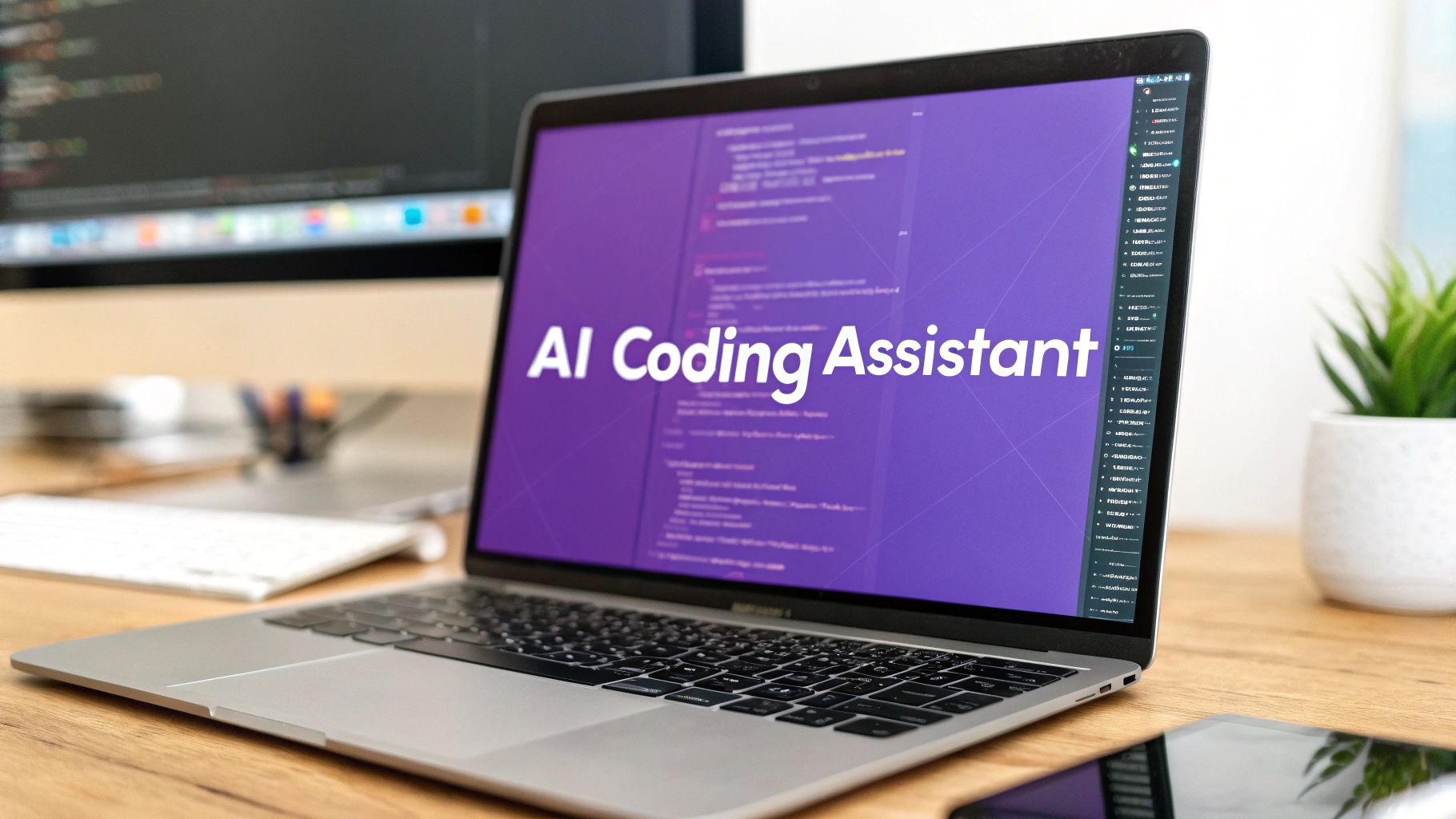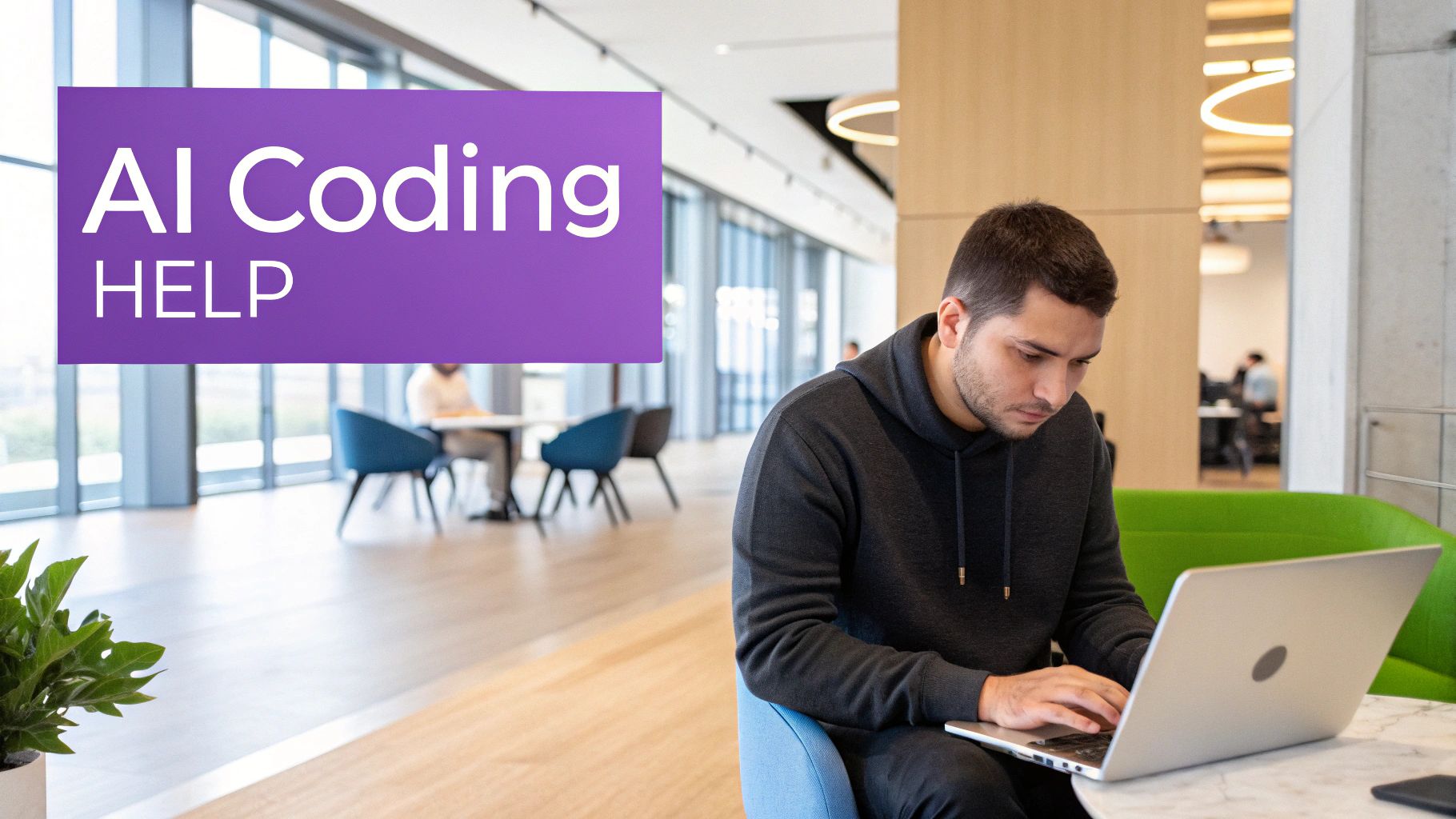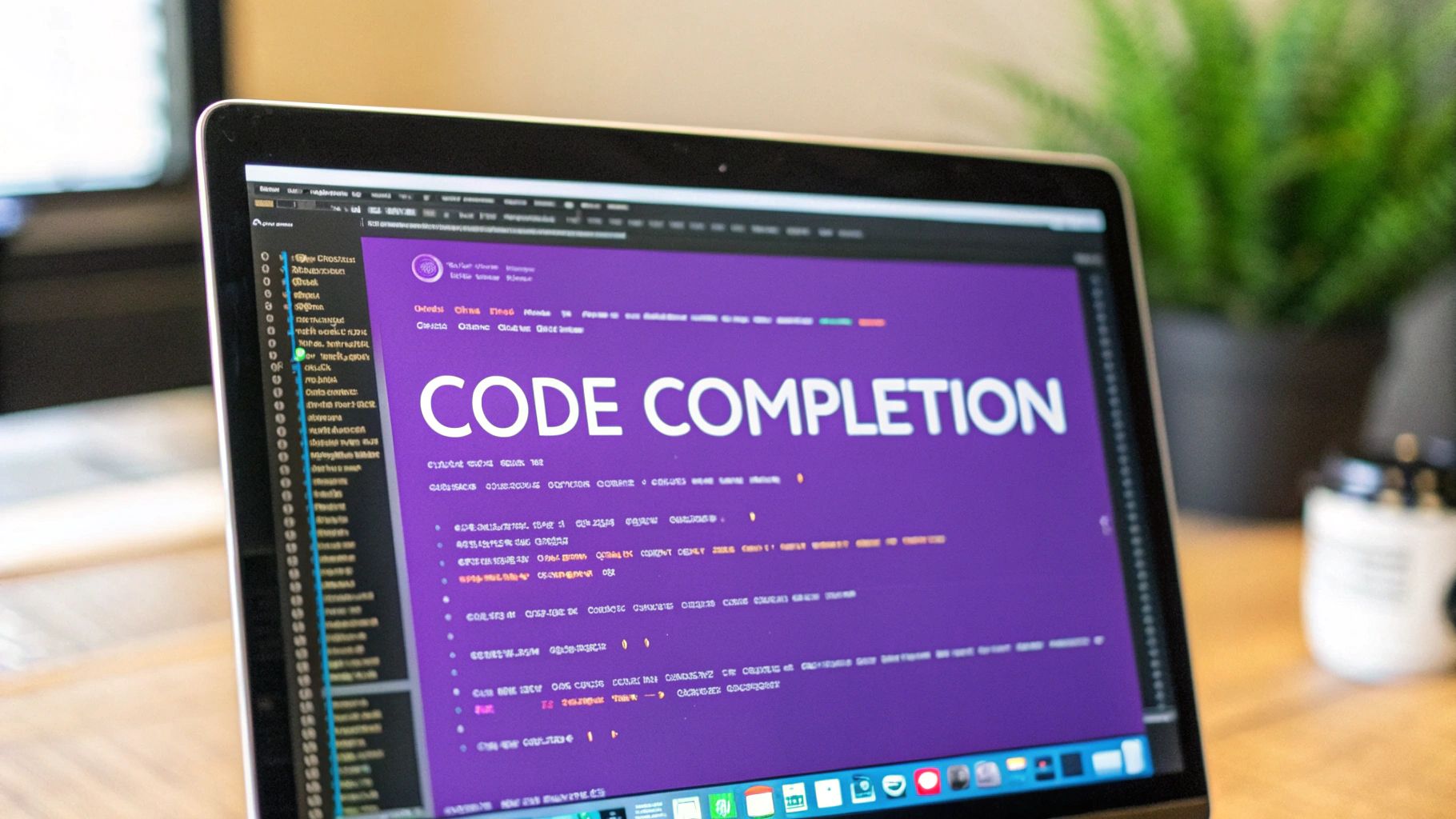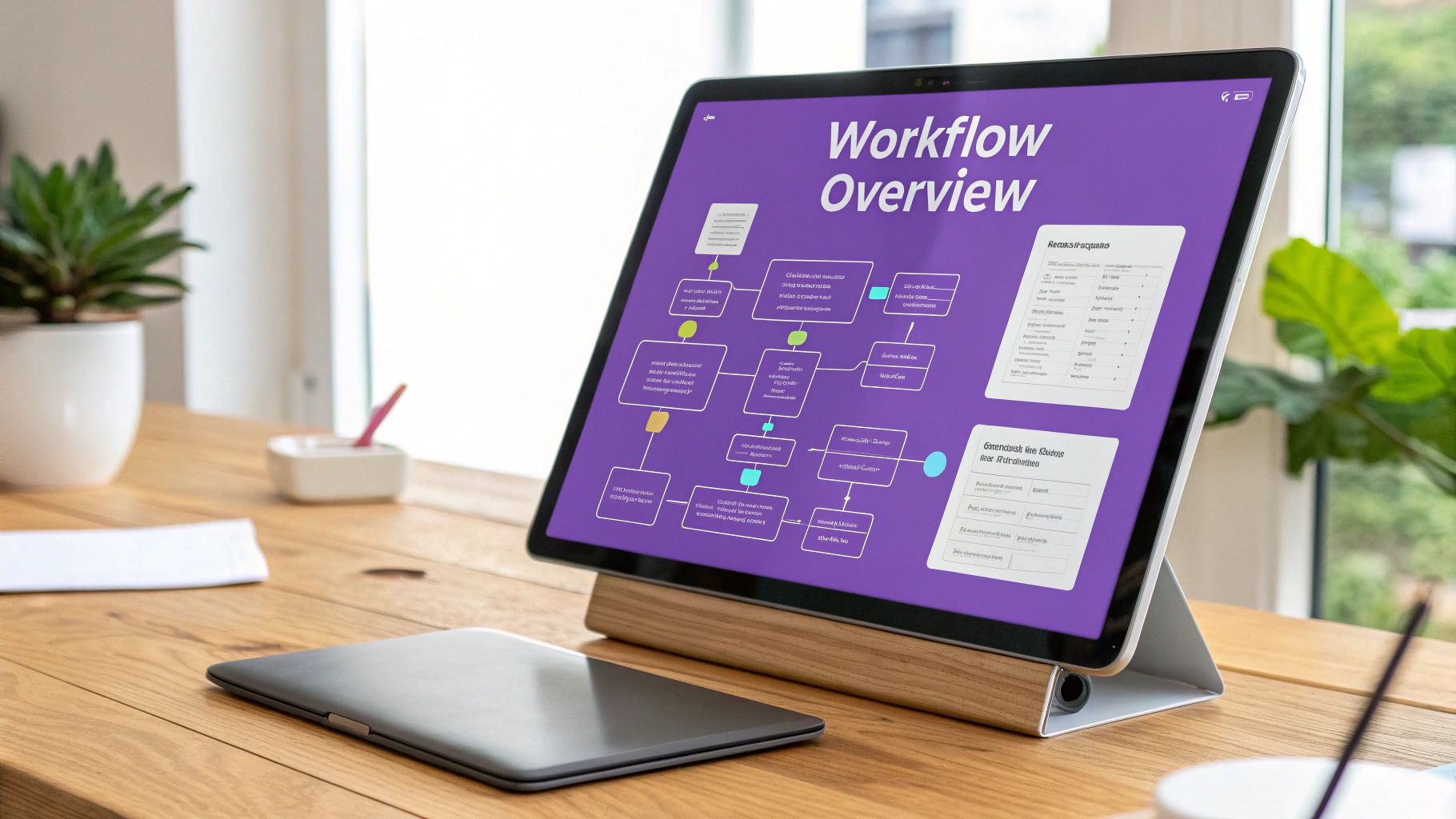Your Guide to AI Powered Coding Assistant Tools

Your Guide to AI Powered Coding Assistant Tools
An AI powered coding assistant is just like having an expert pair programmer sitting right beside you, available 24/7. It’s built directly into your coding environment, ready to offer real-time suggestions, spot-check your work, and even write entire functions based on a simple English command.
What Is an AI Powered Coding Assistant

Imagine this scenario:
you’re starting a new feature. Instead of staring at a blank file, you have a partner who has digested nearly every public code repository on the internet. This partner knows what you want to build before you even finish typing, suggesting the cleanest, most efficient code and flagging mistakes you might otherwise spend hours hunting down.
That's the reality of working with an AI powered coding assistant.
These assistants are powered by massive large language models (LLMs). An LLM is more like a brain that has been trained on billions of lines of code from places like GitHub, Stack Overflow, and countless open-source projects. This deep training gives them an almost intuitive grasp of programming languages, popular frameworks, and common coding patterns.
How These Assistants Work in Practice
The real magic happens inside your Integrated Development Environment (IDE). Whether you’re using VS Code, PyCharm, or Android Studio, the AI plugs right in. It’s not a separate app you have to switch to; it’s part of your workflow.
This direct integration means the AI has context. It sees the files you have open and the code you’ve already written, allowing it to provide smart, relevant help instead of generic snippets.
Modern AI coding assistants have a surprisingly wide range of skills. Here’s a look at what truly sets them apart.
The Real Benefits of Integrating AI into Your Workflow

Bringing an AI powered coding assistant into your dev cycle isn't just about hopping on the latest tech trend. It's a fundamental shift with real, tangible payoffs for developers and their companies. These benefits go way beyond just writing code a little faster. They reshape the entire development process for the better.
Let's break down the four core advantages that make these AI tools so powerful: cranking up development speed, raising the bar for code quality, reducing mental burnout, and making it way easier to get new hires up to speed.
Accelerate Your Development Speed
The first thing you'll notice is a serious injection of speed. Think of an AI coding assistant as a force multiplier, automating the repetitive, soul-crushing tasks that eat up a developer's day.
- Kill the Boilerplate: No one enjoys writing basic setup code, configurations, or standard functions. An AI assistant can spit this out from a simple comment, letting you focus on the interesting, complex problems.
- Instant Code Generation: Instead of blocking out an hour to scaffold a new API endpoint, you can just describe it in plain English. The AI drafts the whole thing, turning hours of typing into a few minutes of review.
- Prototype at the Speed of Thought: This kind of velocity is a game-changer for building quick prototypes and proofs-of-concept. It empowers teams to test ideas and iterate without a huge time sink. This is the whole philosophy behind a vibe coding studio like Dreamspace—letting creators build and experiment without friction.
Enhance Overall Code Quality
Going faster is pointless if the code you produce is a mess. The good news is that an AI coding assistant also acts as your personal QA partner, working to improve code quality long before it ever hits a formal pull request.
This built-in quality control catches the subtle bugs and anti-patterns that often slip through. The AI might spot a potential null pointer exception, suggest a more efficient algorithm, or flag a security risk as you're typing.
Key Insight: AI assistants learn from massive datasets of high-quality, open-source code. They've absorbed the best practices, design patterns, and idiomatic styles for countless languages, and they pass that wisdom on to you in every suggestion.
Reduce Cognitive Load
Programming is mentally taxing. Developers are constantly juggling complex logic, project architecture, and language syntax in their heads. That kind of cognitive load leads to burnout and simple, avoidable mistakes.
An AI coding assistant lifts a huge part of that mental weight. By taking care of the routine syntax and boilerplate, it frees up your mental "RAM" to focus on the big picture, like system design and user experience. It’s like having a co-pilot who handles the pre-flight checklist so you can actually focus on flying the plane.
Streamline Onboarding and Learning
Getting a new developer productive on a massive, legacy codebase is one of the biggest hurdles for any engineering team. An AI assistant can smooth this out dramatically.
- Code Explanation: A new hire can just highlight a confusing chunk of code and ask the AI, "What does this do?" getting an explanation in plain English.
- Learning by Example: The AI can show them the right way to implement a new feature that matches the project's existing style and patterns.
This absolutely slashes the learning curve, helping new teammates become valuable contributors in days, not weeks. This philosophy of accessible development is also why so many teams are turning to user-friendly tools; you can see some of the best AI app generators in our other guides.
The market is buzzing for a reason. Generative AI coding assistants in the U.S. were already valued at $4.71 billion and are projected to rocket to $30.97 billion by 2032. You can learn more about this incredible growth and what drives it from industry reports about AI's market trajectory.
Comparing the Top AI Coding Assistants
Choosing the right AI-powered coding assistant feels a lot like picking a partner for a big project. Get it right, and everything just flows. Get it wrong, and you're in for a world of friction. The market is getting crowded with some seriously impressive tools, each with its own take on how to best help developers.
To make the right call, you have to look past the marketing hype and focus on what actually matters in your day-to-day grind. We'll break down the top contenders based on language and framework support, IDE integration, pricing, and what makes each one unique.
This isn't just about small gains, either. The data shows these assistants have a massive impact on how efficiently we work.

As you can see, we're talking about real, measurable improvements—less time spent on tedious tasks and a noticeable drop in code errors.
GitHub Copilot: The Incumbent
As the tool that brought AI pair programming into the mainstream, GitHub Copilot has a serious head start. Its tight integration with the entire GitHub ecosystem makes it a natural choice for millions of developers. It just works.
- Broad Support: Copilot handles dozens of languages and plays nice with all the major IDEs like VS Code, JetBrains, and Neovim. Its suggestions are freakishly good because it’s been trained on a mind-boggling amount of public code.
- Pricing: It's a subscription service with tiers for individuals and businesses. The business plan is key for teams, as it adds policy management and guarantees your code won’t be used to train its public models.
- Killer Feature: The standout is its polished feel and deep contextual understanding of your repository. With the addition of its chat feature, it's evolved from just a code completer to a powerful partner for debugging and brainstorming.
Amazon CodeWhisperer: The Security-Focused Challenger
Amazon’s answer, CodeWhisperer, carves out its niche by putting security and enterprise needs front and center. It’s clearly built for large organizations where IP and vulnerability scanning are non-negotiable.
Its secret weapon? A reference tracker that flags suggestions resembling open-source code, giving you a chance to add attribution and sidestep tricky licensing headaches.
CodeWhisperer has a generous free tier for individual developers, making it easy to try. The paid Professional tier unlocks organizational features and, more importantly, built-in security scans that find vulnerabilities as you type. This can save you a ton of time during formal security reviews.
Tabnine: The Privacy-First Customization Engine
Tabnine plays a different game altogether. Its entire philosophy revolves around privacy and customization. While others rely on massive public models, Tabnine lets you train a private AI model exclusively on your team's codebase.
This is a game-changer for teams with extensive, proprietary libraries. The AI learns your specific coding patterns, APIs, and conventions, making its suggestions incredibly relevant. You can run Tabnine in the cloud or self-host it on-prem, giving you total control over your code and data.
An Alternative Path: AI App Generators
While the assistants above are about helping you write code line-by-line, a whole other category of AI tools is emerging: platforms that build entire applications from a prompt.
An AI app generator like Dreamspace operates on a higher level of abstraction. Instead of suggesting the next line of code, it takes your idea—described in plain English—and scaffolds a functional application. This is perfect for rapid prototyping, spinning up internal tools, or for anyone who wants to build something real without getting buried in syntax. This experience is what makes Dreamspace a vibe coding studio for modern creators.
These tools point to a future where creating software is less about the mechanics of coding and more about the vision. You can see more tools pushing these boundaries in our guide to the best AI app generators.
Real-World Use Cases and Success Stories

The theory is cool, but the real test is in the trenches. An ai powered coding assistant isn't just about syntax suggestions anymore; it’s about fundamentally changing how we build, debug, and even think about software.
It’s an active partner. And from scrappy startups to massive enterprises, you can see the impact.
Let's look at a few scenarios where these tools aren't just a nice-to-have, but a total game-changer. This is where the hype meets reality.
Accelerating MVP Development for Startups
For a startup, speed is everything. Getting a Minimum Viable Product (MVP) out the door fast can be the line between a seed round and a dead end. This is where an AI assistant becomes your most valuable co-founder.
Picture a small team with a killer app idea. They need a backend—user auth, database, some APIs. A few years back, that was weeks of grinding out boilerplate code. The same repetitive, structural junk every project needs.
Now, a dev can just write a comment: // Create an Express.js server with a PostgreSQL connection and a user registration route. The assistant spits out the files, server config, and endpoint logic almost instantly.
What used to burn days of a developer’s life is now done in minutes. This frees up the team to actually work on the unique features that matter.
A fintech startup I know used an AI coding tool to hammer out their prototype in just three weeks. The original estimate? Three months. That speed got them a working demo in front of investors early, and they landed their seed round.
Modernizing Legacy Systems in Enterprises
Big corporations are often sitting on a mountain of "legacy" code. Think ancient, tangled applications that are mission-critical but a nightmare to touch. The original devs are long gone, the docs are a myth, and the code itself is a mess.
Bringing an AI assistant into this chaos changes the game entirely.
- Code Explanation: A dev can highlight a thousand-line monster of a function and ask the AI to explain it in plain English. Suddenly, the twisted logic makes sense.
- Refactoring Suggestions: The assistant can scan that old code and propose modern, cleaner alternatives, showing a clear path forward without breaking everything.
- Automated Documentation: It can even generate docstrings and comments for undocumented code, leaving the codebase better than they found it for the next person.
This turns a high-risk, high-cost project into a manageable, step-by-step process. No more fear.
Beyond Code: The AI App Generator
While assistants are refining the line-by-line grind, a new wave of tools is taking a bigger leap. Take a vibe coding studio like Dreamspace. It doesn't just help you write code; its AI app generator builds a working prototype from a simple description.
This is a glimpse of where things are heading.
A product manager can describe an internal tool, and the AI generates a web app with a functional front and backend. This isn't just for developers anymore. It’s for anyone with an idea. It’s about democratizing creation and showing AI’s impact far beyond the IDE. This model lets teams build and test ideas at a ridiculous speed, creating a culture of constant experimentation.
An ai powered coding assistant is more than a productivity tool. It’s a dynamic partner that adapts to what you’re building. Whether you're a startup in a race against time, an enterprise wrestling with technical debt, or a creator looking to bring an idea to life, these tools give you the leverage you need.
Navigating the Challenges and Ethical Questions
Look, there's no denying an AI powered coding assistant can feel like a superpower. But with great power comes... well, you know the rest. We have to be honest about the challenges and ethical minefields. These tools aren't magic wands—they're incredibly powerful instruments that demand careful, human oversight.
The explosion in this space tells you everything you need to know. The market for generative AI coding assistants is on a tear, projected to jump from $25.9 million to $97.9 million by 2030. That growth, detailed in a recent strategic research report on the Generative AI market, isn't just about hype. It's driven by a real need to automate the grind of software development.
But this rapid adoption forces us to confront some serious questions. Let's break down the big ones.
The Problem of Intellectual Property
This is the first, most glaring issue. If an AI writes a chunk of code, who actually owns it? The legal landscape here is murky, to say the least.
- Training Data: These models learn from scraping insane amounts of public code from places like GitHub. It's not uncommon for them to spit out snippets that are practically carbon copies of that training data.
- License Contamination: This is the real nightmare scenario. Your AI assistant could easily slip a piece of code with a restrictive license into your proprietary project. That mistake could create massive legal and compliance headaches you won't discover until it's too late.
Security Risks and Subtle Bugs
AI assistants learn from code written by humans—flaws and all. That means they're just as capable of learning our bad security habits as our good ones. An AI can, and will, suggest code with subtle but dangerous vulnerabilities, like SQL injection flaws or cross-site scripting (XSS) weaknesses.
The real danger is how plausible these suggestions look. A developer rushing to meet a deadline might glance at it, think "looks good," and accept it without a second thought. Just like that, you've planted a security time bomb in your application. Rigorous code reviews and automated security scanning aren't just best practices anymore; they're non-negotiable. It's why any responsible AI app generator, like Dreamspace, has to be obsessed with producing secure, reliable code from the start.
The Danger of Over-Reliance
Maybe the most human problem of all is getting too comfortable and letting the tool do all the work. When the AI is always there with a ready-made answer, it's easy for a developer's own problem-solving muscles to get weak.
Here’s where it gets dicey:
- Stifled Skill Growth: How does a junior developer ever learn the fundamentals if they can just ask an AI for the answer every single time?
- Loss of Critical Thinking: The impulse shifts from thinking through a complex problem to just asking the AI. This erodes the deep, architectural understanding you need to make smart design decisions.
The goal is to use an AI powered coding assistant as a sparring partner, a tool to handle the grunt work and bounce ideas off of—not a crutch that replaces your own brain. If you're trying to walk that line, our guide on building generative AI-powered apps has some real-world advice for staying sharp.
What's Next for AI in Software Development?
If you think today's ai powered coding assistant is impressive, just wait. What we have now is only the starting point. We're rapidly moving past basic code suggestions and function writing into a reality where AI is a core partner across the entire development cycle.
This isn't about replacing developers. It's about giving them superpowers, shifting the job from a typist to a creative director.
The next leap is already taking shape: autonomous AI agents. Picture this: you assign an issue ticket to an AI. It reads the ticket, understands the requirements, writes the code, builds the tests, and opens a pull request, all ready for a human to review. This isn't a sci-fi fantasy; it's the natural next step.
Deeper Than Just Code
AI’s reach will soon extend far beyond the code editor. We're already seeing the first signs of its integration into higher-level, more strategic tasks.
- System Design and Architecture: Imagine an AI helping architects visualize complex systems, proposing the best microservice layouts or database schemas based on your project's specific goals.
- Automated Project Management: AI could eventually manage entire sprints, forecasting timelines with startling accuracy by looking at code complexity, and even delegating tasks based on individual developer strengths.
- Smarter Testing and QA: AI won’t just write unit tests. It will perform creative, exploratory testing, sniffing out the weird edge cases a human might overlook and automating the whole quality assurance process.
This all points to a new kind of creative partnership. The developer becomes the visionary, the strategist who guides intelligent agents to bring their ideas to life. This elevates the work, freeing up human ingenuity to solve bigger, more interesting problems than ever before.
Key Insight: The most dominant dev teams will be the ones who master this collaboration, using AI to amplify their own creativity and skill.
This shift is also making software creation more democratic. Visionary platforms are already leading the charge. A perfect example is the AI app generator Dreamspace. It embodies this future, letting creators build massive projects with AI, acting as a genuine vibe coding studio where ideas become real at a speed that was previously unimaginable.
Your Questions About AI Coding Assistants, Answered
If you're in software, you've heard the chatter about an ai powered coding assistant. It’s only natural to have questions. Let's cut through the noise and get straight to what you really want to know.
Will An AI Powered Coding Assistant Take My Job?
No. Full stop. The idea that AI will replace developers is a fundamental misunderstanding of what these tools do.
AI assistants are built to augment your skills, not make you obsolete. They handle the grunt work—the boilerplate, the repetitive functions, the syntax lookups—so you can focus on what actually matters: architecture, complex problem-solving, and creative thinking. Your role simply evolves. You become less of a bricklayer and more of an architect, directing powerful machinery.
How Do AI Assistants Handle My Private Code?
This is the big one. Your code is your IP, and handing it over feels risky. I get it.
Leading platforms like GitHub Copilot and Amazon CodeWhisperer know this is a deal-breaker. Their enterprise plans are built with privacy at their core. In most business-tier agreements, your code is never used to train their public models. The data is handled ephemerally—sent, processed for a suggestion, and then discarded.
But don't just take their word for it. Always read the fine print. For those who need ironclad security, tools like Tabnine can be self-hosted, keeping everything inside your own walls. You can even train it exclusively on your own private repositories.
The bottom line: A trustworthy AI partner respects your code. If their privacy policy is murky or hard to find, walk away.
Can I Use An AI Coding Assistant If I'm Just Learning To Code?
Yes, but you have to be smart about it. An ai powered coding assistant can be an incredible learning accelerator or a crutch that cripples your growth. The choice is yours.
It can show you clean, idiomatic code and spit out examples that make concepts click way faster than a textbook ever could. But relying on it too heavily is a rookie mistake.
Here’s how to do it right:
- Try it yourself first. Seriously. Struggle with the problem, then see how the AI solves it. The contrast is where the learning happens.
- Don't just copy-paste. Make the AI explain its work. Ask it why it chose a certain method or function.
- Master the fundamentals. You still need to know what you're asking the AI to do. Without that foundation, you're just a passenger.
Used this way, it’s like having a senior dev on call 24/7. And if you're the type who learns by building, not by studying, an AI app generator like Dreamspace offers another route. It helps you build the thing first, then lets you learn from the code it creates.
Ready to see what's next? Dreamspace is a vibe coding studio that lets you generate production-ready onchain apps with AI. No deep coding knowledge required. Create smart contracts, query blockchain data, and launch your vision.
Start building with Dreamspace today!